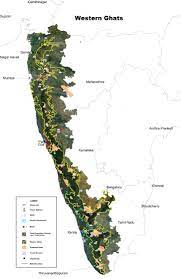
Mountains of Life: Preserving the Western Ghats
The Western Ghats, a prominent mountain range along the western coast of India, is recognized as one of the world’s most significant biodiversity hotspots. Its unique ecological and cultural value makes its conservation imperative.
Biodiversity Richness
The Western Ghats are a treasure trove of biodiversity, harboring a vast array of plant and animal species, many of which are endemic and found nowhere else on the planet. The preservation of this biodiversity is essential for maintaining the delicate balance of ecosystems and the ecological services they provide.
Ecosystem Services
The Western Ghats provide invaluable ecosystem services that benefit both humans and the environment. These services include water regulation, carbon sequestration, soil fertility maintenance, and climate regulation. The loss of these services due to habitat destruction and degradation would have far-reaching consequences.
Water Security
The Ghats act as a major water catchment area, supplying water to numerous rivers and streams that sustain agriculture, industries, and local communities. Conserving the Ghats ensures a steady flow of freshwater, contributing to water security for millions of people in the region.
Cultural and Indigenous Importance
The Western Ghats are not just a biological treasure; they also hold immense cultural significance. Indigenous communities have thrived in these landscapes for generations, relying on the Ghats’ resources for their livelihoods and cultural practices. Preserving the Ghats respects the rights and heritage of these communities.
Tourism and Recreation
The stunning landscapes, diverse wildlife, and unique flora of the Western Ghats attract nature enthusiasts, researchers, and tourists. Ecotourism and responsible recreation can contribute to local economies while fostering an appreciation for nature, thereby creating a positive cycle of conservation.
 Threats to the Western Ghats
Threats to the Western Ghats
Despite its ecological importance, the Western Ghats face numerous threats, primarily stemming from human activities. Deforestation, urbanization, agricultural expansion, mining, and infrastructure development all pose significant risks to the region’s ecosystems and biodiversity.
Erosion and Landslides
Deforestation and unsustainable land use practices lead to soil erosion and destabilize the slopes of the Western Ghats. This contributes to an increased risk of landslides, which not only endanger human settlements but also disrupt habitats and ecosystems.
Climate Change Vulnerability
The Western Ghats are susceptible to the impacts of climate change, including altered rainfall patterns, temperature increases, and extreme weather events. Conserving the Ghats can enhance their resilience, helping both ecosystems and communities adapt to changing climatic conditions.
Conservation Efforts
Recognizing the urgency of conserving the Western Ghats, various conservation initiatives and policies have been put in place. Protected areas, such as national parks and wildlife sanctuaries, serve as havens for biodiversity. Additionally, sustainable land use practices, afforestation efforts, and community-based conservation projects contribute to safeguarding the Ghats.
Collaborative Approach
Conserving the Western Ghats requires a collaborative approach involving government agencies, local communities, NGOs, researchers, and industries. Such partnerships can leverage collective knowledge and resources to create effective conservation strategies. Strong legal frameworks and policies are essential for ensuring the long-term protection of the Western Ghats. The Western Ghats Ecology Expert Panel (WGEEP) and the Western Ghats Development Programme (WGDP) have played crucial roles in formulating guidelines for sustainable development and conservation.
In conclusion, the Western Ghats stand as a testament to the importance of biodiversity and the intricate relationships between nature, culture, and human well-being. The conservation of this remarkable region goes beyond the protection of individual species; it’s about safeguarding ecosystems, water resources, cultural heritage, and future generations. Through collaborative efforts and thoughtful policies, we can ensure that the Western Ghats continue to thrive as a beacon of ecological richness for years to come.

